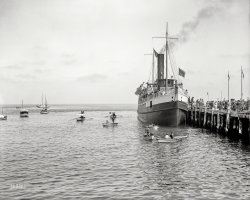
MAY CONTAIN NUTS

Search Shorpy
SHORPY ART

Framed or unframed, desk size to sofa size, printed by us in Arizona and Alabama since 2007. Explore now.
Join and Share
Ad-Free Shorpy
Shorpy is funded by you. Patreon contributors get an ad-free experience.
Learn more.

Recent comments
- What a headache!
- Baldwin 62303
- Baldwin VO-1000
- Cold
- No expense spared
- Tough Guys
- Lost in Toyland
- And without gloves
- If I were a blindfolded time traveler
- Smoke Consumer Also Cooks
- Oh that stove!
- Possibly still there?
- What?!?
- $100 Reward
- Freeze Frame
- Texas Flyer wanted
- Just a Year Too Soon
- WWII -- Replacing men with women at the railroad crossing.
- Yes, Icing
- You kids drive me nuts!
- NOT An Easy Job
- I wonder
- Just add window boxes
- Icing Platform?
- Indiana Harbor Belt abides
- Freezing haze
- Corrections (for those who care)
- C&NW at Nelson
- Fallen Flags
- A dangerous job made worse
Member Photos
The Shorpy
Print Emporium
Print Emporium
Search Shorpy
Search results -- 30 results per page
- Bruiser: 1931
- ... that still have stone curbs and brick streets.
This boat hit everything! Front bumper torn off.
Base of radiator pushed back. ... Posted by Dave - 07/08/2011 - 11:34am -
![Bruiser: 1931 Washington, D.C., 1931. "Auto accident." I will leave it up to Shorpy Nation to determine the location and make of this dented dreadnought. 8x10 safety negative, National Photo Company Collection. View full size.
What exactly is that lightmounted slightly in front of the drivers door, almost on top of the hood? An extra headlamp? A searchlight? I ask because my father once owned a decrepit 40 Ford model sedan that had exactly the same thing, but it was so long ago (I was just 6 or 7 years old then) I never found out what it was for before he sold the car for scrap.
[Parking light. One on each side. - Dave]
MeowThere appears to be a kitten coming through the hole in the gate at the very precise moment the photographer took this picture, thus memorializing himself for eternity or for at least as long as the picture lasts. Very clever, these felines. (Or is that a piece of debris?)
Not that badIt'll buff right out!
Good ObservationIf that ain't a cat it's a dog.
I also like the stone curbs. There are areas in the city I live in that still have stone curbs and brick streets.
This boat hit everything!Front bumper torn off.
Base of radiator pushed back.
RF Fender crumpled
Right headlight turned a little outward.
LF Fender crumpled.
Running board bent downward.
Drivers door is crumpled, with a section rolled up into a fist sized ball.
LR Fender bent.
I'd venture to say this guy did all this himself going to fast, spinning out, and bouncing from solid object to solid object.
[Also: Large hole in windshield on passenger side. - Dave]
The Shadow KnowsAlso memorialized are the photographer's and his camera's shadows!
Danger glassI didn't even notice the broken windshield. What can be seen is a clean break, as the large shards are absent in this view. I would have been looking for the telltale spiderweb of modern laminated safety glass, an invention that is too easy to take for granted.
Based on the hubcap design My guess is that it's a Peerless.
[You were the only person to venture a guess, and you are correct! Circa 1930 Peerless. - Dave]
Buff right out?At least this was in the days when it *could* be economically repaired! Other than the panel in front of the driver's door (which probably could be buffed out), everything else damaged just bolted on.
Today, if that car were more than a few years old, it'd be totaled by the "insurance" company!
ScenarioHit in the driver's side door by another vehicle, which propelled it off the road causing the front-end damage. Doesn't explain the left rear fender well, though.
Such a masculine machine -- like a boxer cut and bruised after a fight.
Glass Cabinet CarsI'm told that for years, my Dutch immigrant grandparents refused to ride in a "glazen kast" (glass cabinet) car because of the danger of glass shards as so clearly evidenced here. Maybe they had a point back then!
Double JeopardyYour grandparents were right. The glass in these cars were extremely dangerous. Equally dangerous were the steering columns which were not designed to collapse during frontal impacts. It was not uncommon for a drivers to be fatally impaled from frontal collisions at speeds as low as 25 mph. So much for the saying "they don't build 'em like they used to"!
A PossibilityThe only crash I can come up with which might match this is the June 1931 crash of the wife of Pennsylvania Senator Davis in Frederick, Maryland, as she was on her way back to Washington from Gettysburg PA. She was driving a coupe and struck in the side while passing a milk truck. No serious injuries, but it did warrant a trip to the hospital.
[This is a four-door sedan, not a coupe. - Dave]
Those Galvanized TubsThose tubs had a great many uses outside their primary use of scrubbing board washtubs.
I spent many a summer day in one as it did duty as an outdoor pool and come Saturday night you could fill it with a 25 lb slab of ice from the ice man to cool down the Royal Crowns and Gunther beer for a backyard party.
Also with a broomstick and twine it doubled as a bass fiddle or if you liked Krupa or Cole you could bang away with a couple of sticks to the tune of either Topsy or Turvy.
1929 PeerlessAppears to be a 1929 Peerless.
(The Gallery, Cars, Trucks, Buses, D.C., Natl Photo)](https://www.shorpy.com/files/images/31032u.thumbnail.jpg)
- Bananas to Baltimore: 1905
- ... makers of fine hardtack biscuits.
Bananas from a boat By the time they shipped them to Baltimore, they must have been all ... the waterfront. The brick foundation closest to the banana boat is likely remains of that conflagration.
A famous Baltimore ... Posted by Dave - 07/08/2014 - 1:03pm -
![Bananas to Baltimore: 1905 Baltimore, Maryland, circa 1905. "Unloading banana steamer." A teeming scene that calls to mind the paintings of Brueghel, if Brueghel ever did bananas. Note the damage from the Great Fire of 1904. 8x10 glass negative. View full size.
Big MikeThese bananas are the variety known as Gros Michel or "Big Mike." They were a larger, heartier, tastier banana than the Cavendish variety that everyone eats today, and hardly any special shipping methods were needed. Just stack them and go. Unfortunately, since cultivated bananas are genetically identical to one another, by the 1950s essentially all Gros Michel bananas were wiped out by one Panamanian fungal disease. The Cavendish was a suitable replacement as it could grow in the same soils as the Gros Michel, but it requires more delicate handling during shipping.
The Cavendish itself is steadily being wiped out by a similar fungus and we may need to look for another replacement in the not too distant future.
Spiders, Oh My!Mackenzie, your family history is probably not far off. I had an ex who discovered a scary-looking spider in a shipment of bananas in the middle of Nebraska of all places about ten years ago. He thought it was dead and went to poke it, and to his surprise, it was alive! Fortunately for him, he was not bitten. I would imagine the threat of spiders and other creepy crawlies would be even greater before shipments passed through inspection. I don't blame your ancestors for being a little scared one bit!
Always have a spare.I like the extra anchor lashed to the railing on the lower left of the frame.I wonder how much it weighs.
NabiscoThe original NBC, the National Biscuit Company, makers of Uneeda Biscuits and more importantly, Mallomars.
Hey, Mister Tally ManSomeone tell the two gents with ledgers (looks like) in the small screened shed to knock one banana off the day's tally, thanks to the one guy in the bunch eating the inventory, in the foreground looking at the camera.
The William Heyser seen on one building was an oyster distributor still in business in 1929, as noted by an ad in my desktop copy of a 1929 Baltimore business publication marking the city's 200th anniversary:
Heyser’s Oysters
Baltimore’s Leading Brand
The William Heyser Co.
Raw Oysters
2201-09 Boston St, Baltimore, Md.
This reminds me of a road projectThree or four guys doing the heavy lifting while a hundred guys watch.
NabiscoFirst known as the National Biscuit Company, makers of fine hardtack biscuits.
Bananas from a boatBy the time they shipped them to Baltimore, they must have been all brown and slimy. I think the evidence supports this.
[As opposed to the way bananas get to America now? - Dave]
Do they still ship them all the way to Baltimore?
Is that a Banana in your handOr are you just... Oh, never mind, it IS a Banana.
Quality ControlNice to see the gent here on the left foreground tasting the produce to make sure that indeed it is a banana. Don't dally you men, the talleys are correct and Harry Ketler's Express boys are in a hurry.
re: BrueghelDave, I'm impressed! Your comparison to Brueghel is dead on. May I suggest a novel to you: Headlong, by Michael Frayn. http://www.themanbookerprize.com/prize/books/80
300 accidents waiting to happenI am speaking of all those bananas and peels on the deck. A slapstick comedian's dream.
Looking SouthwestThis view is looking Southwest from a pier located on Pratt Street. My guess is that it is Pier 3 which is now the location of Baltimore's Aquarium. United Fruit Company (Chiquita Brand) would later build a large Banana handling plant on the Light St. side of the harbor. On a side note, Baltimore rebuilt itself after the fire. The mayor politely but firmly declining all offers of outside help.
How they get here nowThey still arrive on boats, of course, but in a carefully controlled inert atmosphere (usually nitrogen-rich, always oxygen-poor). Banana ships today are among the more specialized transport vessels.
[Plain old air could be considered "nitrogen rich and oxygen poor." - Dave]
Well, there is a pretty faint difference between rich and poor, as regards oxygen. The troposphere is about 21% oxygen, on average. Meanwhile, OSHA defines air below 19.5% as oxygen-deficient. It's a razor edge that we breathe on, and seldom even think about.
But we are talking a sledgehammer beyond that razor. The high parameter for oxygen in modern banana transport is about 4%. If you do not follow the proper ventilation protocol, you will literally suffocate seconds after entering the hold.
And look at the guy... eating a banana while the other guys do all the work! The B.B.B.W.U. (Baltimore Brotherhood of Banana Workers Union) will hear about this!
All star castIs that Corey Feldman and Eddie Murphy in the wagon?!
Daylight comeand me wanna go home.
WatchersI think the guys "watching" are buyers.
Satisfaction GuaranteedBy our Quality Control Department and
On-Site QC Manager!
Testing the ShipmentMan in foreground: "Gotta make sure they're really ready to eat."
Banana MythA good chunk of my genealogy includes generations of Eastern Shore watermen and Baltimore stevedores. The fear among all banana handlers was that tarantulas would be hiding in the bunches. I have no idea how real or factual this fear was, but it's still talked about at family reunions.
Did anyone else think of this?They guy looking at the camera, snacking on a banana, lower left.
1 Timothy 5:18
For the scripture saith, "Thou shalt not muzzle the ox that treadeth out the corn." and "The laborer is worthy of his wages."
Sampling the merchandiseGuy in the bottom left.
You can always tell the accountants -- starched white shirts and ties by the gangplank, best dressed by far, and looking very pleased with themselves!
James Bond?I had no idea that Pierce Brosnan (Lower Center) liked Bananas so much?!
Banana "Myth"My brother-in-law, who was produce manager for many years in one of Canada's largest grocery chains, was often confronted with six- and eight-legged critters that accompanied fruit boxes, including many tropical spiders and roaches. Banana boxes produced some of the largest and scariest spiders because of the nooks and crannies that they can hide in.
Many were deceased but some were not.
One piece of advice from his long years of experience is NEVER, ever, EVER bring home vegetable boxes for moving or storage. You DO NOT want infestations of 4-inch flying roaches.
Now & ThenI didn't know where to post this, so here it is:
A neat page I found- taking old photographs from the Smithsonian's collection, and holding them so they fit into place for a current photograph.
http://jasonepowell.com/
And he gives Shorpy credit for discovery of some of the photos!
The BasinA back-to-front review: National Biscuit building in the distance lasted into the '70's as a rowdy saloon known as Elmer's.
The ancient peak-roofed structures facing us, fronted on Light St., a major north south street.
The two Bay steamers were laying over for their nearby terminals, which lined along Light Street.
The mostly new-looking structures on the right, faced Pratt Street.
The city has a strange, open quality about it, a result of the recent Baltimore Fire of 1904, which gutted the business district east of Light St. down to the waterfront. The brick foundation closest to the banana boat is likely remains of that conflagration.
A famous Baltimore photographer, A. Aubery Bodine, took photos of banana boats being unloaded in the 1950's in nearly the same location as this, with no difference between them.
A Baltimore and Ohio RR "Fruit Pier" was established in south Baltimore in the 50's, which largely replaced the practice shown here.
The area in this photo was known to generations of Baltimoreans as the Basin; today it's the yuppified, allegedly upscale Inner Harbor.
I can't even imagineHow that place could smell.
HumorI would love to be in on the joke they're sharing.
Bolgiano's Seed Store[stanton_square's contributions to Shorpy tend to be of the Joe Friday type: "All we want are the facts." On occasion this blogger stumbles across documents which have both 1) historically relevant facts and 2) overt racism or sexism. In such cases it is sometimes difficult to decide what is worth transcribing. The following 1903 Washington Post article contains such a passage. While I decided to transcribe this passage, I feel obligated to point out the back-handed anti-immigrant racism contained in the first paragraph. The second article, from the American Poultry Advocate, relates the disastrous business impact of the Baltimore fire of 1904 and contains an odd usage of the word 'wonderfully.']
J. Bolgiano & Son, founded 1818. Bolgiano's Seed Store was located at the corner of Pratt and Light. Several heirloom tomato varieties grown today are descended from Bolgiano stock including: Greater Baltimore, John Baer, and IXL Extremely Early.
Washington Post, May 17 1903
English names are not the only ones that have been handed down from Revolutionary times, and often a name that seems to indicate foreign blood represents an old American family. This is illustrated in the firm name of F.W. Bolgiano & Co., of this city, an offspring of a firm of like name established in 1818 in Baltimore. It is Italian in origin, but no longer represents Italian stock more than English. The name is known throughout the country to purchasers of seeds, which the firm grows and sells in many parts of the United State and imports from Europe. …
The firm grows seeds largely in Frederick County, Maryland, and supplies some of the largest seeds houses with certain varieties of seed. The firm now has business connections in more than a dozen States, and customers in nearly every State in the Union and Canada.
American Poultry Advocate, 1904
It is more than probable that every reader of this paper has heard of the wonderfully disastrous fire which so recently burned the heart out of the city of Baltimore. Unless you just happened to know some one who was living or doing business in Baltimore, it is likely that you gave the fire hardly more than a passing thought. But what do you think it means to the people of Baltimore? What do you thing it means for instance, to J. Bolgiano & Sons, the seedsmen who have for eighty-seven years been doing business In the fated city? In all that long period they have never before suffered from fire. Indeed, they felt perfectly safe this time, for when the fire first started it was more than ten city squares away from them. Later, and when they thought they were endangered — though the fire was still six squares from them — they employed two hundred hands and fifty drays and began the removal of their large retail seed stock to one of their warehouses a long distance from the fire, and where they felt everything would be safe. It transpired, however, that by a shifting of the winds the fire ate relentlessly away until both retail stores, offices, packing rooms and warehouses were destroyed. Bolgianos made a brave fight to save the orders and seeds for their thousands of customers, but fate was against them. The orders already booked and the lists of names of multiplied thousands of customers all over the world were lost in the twinkle of an eye.
With absolutely nothing to work with, nothing to aid them except their fair name and excellent reputation, the Bolgianos have set to work with firm hands and brave hearts to rebuild their business. They have already laid in a large stock of the very best farm and garden seeds, notwithstanding the short seed crop of the past season, and will be able to fill orders as usual. Since all their advance orders and names of customers are burned, they have very little to begin on. Will those of our readers who ordered from Bolgiano & Sons write a postal card at once, simply giving your name and postofflce address? Do this whether you are an old or new customer of theirs. Send them your name anyhow, so that they may send you their catalogue another season. Simply address the card to J. Bolgiano & Sons, Baltimore, Md.
Market Growers Journal, 1915, Advertisement.
Originator's stock — the world-famous Tomato "John Baer." The earliest and best Tomato on earth."
Bolgiano's "Long Lost" Lettuce. Excels All Others: On the market, as a Shipper, as a Keeper, in Quality, in Sweetness, in Flavor, in Color, in Profits, in Reliability, in Hardiness.
The Town, Women's Civic League, 1916, Advertisement.
A rich deep velvety green lawn is assured by planting Bolgiano's Druid Hill Park Velvet Green Lawn Grass Seed
Canning Age, Vol 1. 1920.
Glory Tomato, yielding better than 20 tons per acre.
Pittsburgh Pickle, raised by expert grower.
Bolgiano Tomato.
Washington Post, Oct 29, 1920.
J. Bolgiano & Son Fail.
Seed Firm Assents to Bankruptcy and Appointment of Receiver.
J. Bolgiano & Son, wholesale and retail seed growers and distributers, today assented to proceedings in the United Sates court adjudging the firm bankrupt and placing it in the hands of receivers.
The seed house was established more than 100 years ago by the great-grandfather of Charles J. Bolgiano, present head of the firm, and is engaged in marketing the seed products of more than 10,000 acres of land in Canada, as well as seeds from ten states of the American Union, Holland, France, England, the Canary Islands and other foreign countries.
"Hawaii" and bananasI recall reading James Michener's "Hawaii", when the pregnant Jerusha Hale (played by Julie Andrews, in the film version) is aboard ship for the gruelling journey to Hawaii. In order to keep her strength up, she is forced to eat bananas which, by this time in the journey are nearly liquid in their black, greasy skins. She's so disgusted with them that she finally throws them overboard.
When she arrives in Hawaii, she is offered bananas and doesn't realize that the yellow fruit is the same thing...
Dock SmellIn response to Darnuad's comment: my childhood memories of the harbor involve the enveloping odor of SPICES. McCormick's was there, and it was the best-smelling place I've ever been.
Anti-immigrant racismAs one whose name is reminiscent of English blood, I don't find the mere mention of my name as offensive, nor would I think Mr Bolgiano found anything backhanded or racist in his story. He was probably thrilled to get the free publicity.
Ship NameDoes anyone know the name of this ship?
Thanks
james@thebeckhams.us
(The Gallery, Baltimore, Boats & Bridges, DPC)](https://www.shorpy.com/files/images/4a30328a.thumbnail.jpg)
- Baltimore Luggers: 1905
- ... Thanks
Baltimore's First Powered (Steam) Police Boat The Lannan was Baltimore's first police boat, put in service in 1891. Before that rowboats were used in the harbor.
... Posted by Dave - 08/19/2017 - 8:30pm -
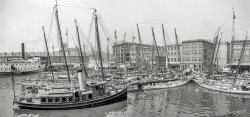
- Water Slide: 1900
- ... ship, sipping punch; the hoi polloi are aboard the new boat, hanging on for dear life; and the great unwashed -- well, they're on ... - Dave]
Now I see. I've only seen the kind of boat launches "on TV" where they slide straight out into the water, so I ... Posted by Dave - 02/27/2015 - 1:16pm -
![Water Slide: 1900 Sept. 15, 1900. Wyandotte, Michigan. "Launch of freighter Howard L. Shaw." Thrilling prequel to this image. 8x10 inch glass negative. View full size.
UnbelievableIn those days you could ride out a ship launch? Hold Tight! Dangerous...kids? Today the liability would never allow that!
Lookey Lou'sLooking at all the people in boats and on shore this must have passed as big entertainment in the day.
Grassy Island LighthouseI wonder if that's the Grassy Island Lighthouse behind the Howard L. Shaw. The view might be correct - the question where was that original lighthouse? From Here https://en.wikipedia.org/wiki/Grassy_Island it seems that the original island has been covered over with dredging material, so the shape is different.
This location on Google Maps seems to show the correct shape of a launching slip (or whatever it's called) pointing right at Grassy Island.
Sorted by rankLooks like the persons of stature are aboard the second ship, sipping punch; the hoi polloi are aboard the new boat, hanging on for dear life; and the great unwashed -- well, they're on shore, and about to get washed.
Prequel or... sequel? To me it looks like the aftermath of the linked photo.
[Tell us how you think that would work. First it's just sitting in the water. And then later, it lands with a giant splash in the exact same place? - Dave]
Now I see. I've only seen the kind of boat launches "on TV" where they slide straight out into the water, so I assumed that's what the previous image was... the boat before it slid into deeper water with a splash. Now I'm guessing the boat slid sideways into the water? I wondered what all those logs at the right of the previous photo were for.
Howard's EndIn 1969 the hull of the Howard L. Shaw was sunk off the coast of Toronto, to become part of the breakwater for the Ontario Place entertainment complex. She remains there today.
Mamajuda?Is that the now submerged Mamajuda Island and lighthouse in the background?
The first Bob-Lo boat.Passing in the background is the boat/ferry that first took passengers to the Bob-Lo Island Amusement Park from downtown Detroit. Built by the Detroit and Windsor Ferry Company in 1892 as the "Promise". A few years later to be replaced by the "Columbia" and "Ste. Claire". The Ste. Claire currently undergoing full restoration for a new job near New York.
TraditionalThey're still launching them this way in the Great Lakes. From last October, here's a video of the launch of the USS Detroit (LCS-7) in Marinette, WI. Still lots of gawkers, but no one riding it down the ramp.
Pictures of a lifetimeThe full history of the Howard L. Shaw here.
Background LighthouseThe lighthouse and island hasn't been around for a long time. That is the Mamajuda Island Light and for decades has only been marked by a buoy.
(The Gallery, Boats & Bridges, DPC)](https://www.shorpy.com/files/images/SHORPY-4a05235a.thumbnail.jpg)
- Mainstream Media: 1899
- ... which her fenders are stowed.
Commodore of the Boston Boat Club A.W. Chesterton founded a company, in Boston, selling steamboat ... Chesterton himself was one time Commodore of the Boston Boat Club.
I stand corrected. It was the Boston Yacht Club. That's what ... Posted by Dave - 07/20/2017 - 12:02pm -
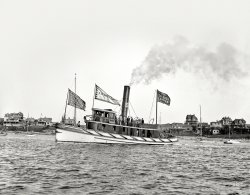
- North Star: 1905
- ... Line. It came to 9 million pounds.
What type of boat (ship) is the North star? It has the rump of a schooner and the pointy ... tilted smokestack, it looks like a larger version Popeye's boat.
1889-1908 NORTH STAR . Built by Globe Iron Works, Cleveland, ... Posted by Dave - 07/30/2012 - 10:43pm -
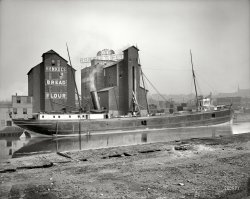
- Primitive Ferry: 1907
- ... seem to be connected to anything that would propel the boat.
Educational value of Shorpy Shorpy never ceases to amaze me. I was ... of the USGS shows an operating ferry.
Work Detail Boat Makeover.
Row, Row Your Boat Notice that the railing where the guy ... Posted by Dave - 08/21/2012 - 7:50pm -
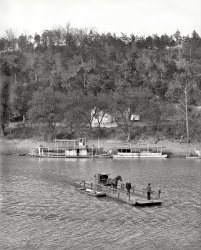
- Oarsman Bolles: 1923
- ... photo. "Dead hotties"? - Dave]
Row, Row, Row Your Boat Harry looks like he could row a warship, with that barrel chest! It's ... Posted by Dave - 07/27/2012 - 1:48pm -
![Oarsman Bolles: 1923 March 20, 1923. "H.A. Bolles, Annapolis. Crew Captain." View full size. National Photo Company Collection glass negative, Library of Congress.
Harry Bolles, R.I.P.Commander Harry A. Bolles died July 18, 1943, when his Coast Guard plane crashed into a mountain in Alaska. The Navy named a drydock in Puerto Rico in his memory.
Dead HottiesEh ... sure, I'd go for it.
[Or maybe "Handsome Rakes." Done! - Dave]
J Crew crewIn a contemporary J Crew catalog, Mr. Bolles' worn sweatshirt would retail for $80.
Harry BollesHarry Bolles was in the class of 1923 at USNA, the only Bolles with the H initial ever at the Academy. He also played football. Note: Nice Crew sweatshirt - had one like that when I rowed there in the late 70s.
[Hm. I can certainly see why he might have wanted to use the initial. - Dave]
Handsome LadsDave, given that Shorpy has a prominent sub-section of "Pretty Girls", maybe it's time to start one for "Handsome Lads" - PER
[Not even one vote for "Dead Hotties"? - Dave]
WowWhat a hot patootie! He looks a little like Richard Gere around the eyes.
[Maybe these guys should have their own gallery tag to go above the photo. "Dead hotties"? - Dave]
Row, Row, Row Your BoatHarry looks like he could row a warship, with that barrel chest! It's clear why he was captain, I wonder what the team's stats were?
Mr. BollesHandsome!
Just Wild About HarryEven with his unfortunate name (and fate!) he is pretty stunning! I wonder what his middle name was? I'm not clever enough to come up with something.
News LeakDave, because of your comment, I expect a free Shorpy seat protector, when they become available. For my new chair.
(The Gallery, Handsome Rakes, Natl Photo, Sports)](https://www.shorpy.com/files/images/08044u.thumbnail.jpg)
- Crawlspace Canoe: 1950s
- ... and float off to points unknown. View full size.
Boat building/root hacking tool That axe-on-its-side is called an adze. i didn't realize you could use it to hollow out a boat, we use ours to hack stumps and roots.
Darn I should have measured ... Posted by Dave - 10/17/2015 - 11:37am -
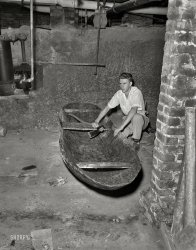
- Edna and Olga: 1925
- ... resist using one form of the word ogle.
Crude Boat In this self-consciously rustic scene the boat is self-consciously crude too -- no ribs, thwarts resting on a stringer ... Posted by Dave - 08/01/2011 - 12:39pm -
![Edna and Olga: 1925 May 6, 1925. Washington, D.C. "Miss Edna Rush & Miss Olga Joy." National Photo Company Collection glass negative. View full size.
DepthThere looks to be only six inches of water, hope they were able to catch something besides our eyes!
Fishing in PearlsMust be a high class fishing hole, they're both wearing pearls. They must be asking themselves "Do I have to put my feet in that mucky water?"
Rush to Joynothing more to add.
The fishing hole is most likely the C&O canalThe steep rocky banks are a giveaway. Although there is a building in the background, of which there are very few. It looks like it was partially drained at the time.
Edna!Miss Edna Rush was a popular nightclub and vaudeville entertainer who at one time had her own radio show. In 1945 she married actor James Dunn (an Oscar winner for "A Tree Grows in Brooklyn").
Musty monikersI always find it interesting the way names, like clothing and so many other things, go out of style. I can't say I've heard of too many Ednas or Olgas nowadays.
Here's a list of some old-fashioned names to give some examples of what I mean (though interestingly, neither Edna nor Olga are on it... lol).
Ogling Olga!Not so much really, but couldn't resist using one form of the word ogle.
Crude BoatIn this self-consciously rustic scene the boat is self-consciously crude too -- no ribs, thwarts resting on a stringer with no knees or gussets securing it to the hull, oarlocks on blocks through bolted with huge unsightly bolts to the sheer strake, itself held on by staples (probably the joint is not watertight), and the area below that shows no seams. It couldn't be plywood in that period, could it? But that's what it looks like. If we could see all of it, it might well be a pram (square in the bow as well as the stern where Edna, or is it Olga, is fishing.)
Which leads me to wonder where they got such a craft in the (even then) fairly refined nation's capital.
[The craft is a small river punt. - Dave]
"Oprah...Uma. Uma...Oprah"Edna...Olga. Olga...Edna.
Rememberwhen fishing was sexy?
Whither Progress It's depressing to note that wooden row boats are now found only in maritime museums or wealthy collectors storage sheds. Those clunky, heavy and slow handmade half-crates were pretty much indestructible, as long as you hauled them out now and then, but you could never get the stink of worms and fish out of the bilge.
(The Gallery, Boats & Bridges, D.C.)](https://www.shorpy.com/files/images/13547u.thumbnail.jpg)
- Dorn Hotel: 1941
- ... goes back a lot farther than I thought.
Center Boat It is a cat boat that is large enough to have an enclosed cabin. This sailboat type was ... Posted by Dave - 08/12/2012 - 11:15am -
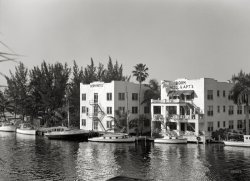
- Joy Committee: 1938
- ...
New York Amsterdam News, July 2, 1938.
Boat Ride Promising
Garnering the major share of the week's spotlight ... Stephens and many others.
Weegee and the excursion boat On August 17, 1941, panic swept a crowd of Negro Odd Fellows waiting to ... Posted by Dave - 01/18/2014 - 8:08am -
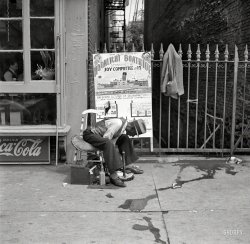
- Payday: 1905
- ... before the Great Fire.
DAY-O Looks like the banana boat came in, and some of the workers got a sample.
The banana boat Bodø is detailed in this article , near the bottom:
"The ... Posted by Dave - 09/11/2013 - 9:44am -
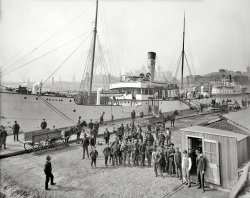
- Batista en Washington: 1938
- ... glass negative. View full size.
V-16 Show Boat Wow. 1938 Cadillac Series 90 Convertible Sedan with body by Fleetwood ... Posted by Dave - 08/23/2012 - 6:18pm -
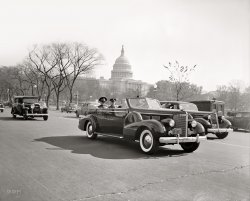
- Uncle Charlie: 1949
- ... photo Is absolutely.
Freaking.
Awesome.
Boat terminology That's a bowsprit, not a mast, to which the jib is ... of boats are nice.
Where or Where? Where is the boat today? Is Uncle Charlie still with us?
(ShorpyBlog, The Gallery, ... Posted by Dave - 04/22/2009 - 3:13pm -
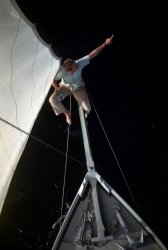
- Smooth Sailing: 1936
- ... dressed for aquatic retrieval of wayward vessels.
Boat chasers The lake is only 950 x 420 feet so they probably just ran ... seat. -Dave]
Weather Gauge Looks like the closest boat has what little wind there is (he's got the weather gauge) which means the ... Posted by Dave - 02/04/2015 - 2:03pm -
![Smooth Sailing: 1936 April 8, 1936. "Pontiac convertible at Spreckels Lake, Golden Gate Park, San Francisco." A model family's model boats. 8x10 acetate negative. View full size.
What a streamlined beauty!The Pontiac's nice, too!
BA-BOOM!
That NEVER gets old!
["At her best with the top down." Watch and learn, lads. - Dave]
7-Foot VoyageWhat did they do when the sailboats drifted beyond the reach of the bamboo? Nobody in this photo seems dressed for aquatic retrieval of wayward vessels.
Boat chasersThe lake is only 950 x 420 feet so they probably just ran around to the other side to get their wayward boats. Or maybe that nice lady will give them a ride. It is still home of the San Francisco Model Yacht Club.
Dress CodeHer ensemble seems better suited to leaning against a Cadillac ... or a LaSalle, anyway.
Contrasting contemporariesI doubt that Steinbeck was spending much time hanging out with these folks.
Two-seater?It must have been crowded when all four of them rode to the lake in that 2-seater cabriolet.
[This four-passenger Pontiac DeLuxe Cabriolet has a rumble seat. -Dave]
Weather GaugeLooks like the closest boat has what little wind there is (he's got the weather gauge) which means the others are trying to sail with nearly zip wind. In any case it doesn't look like there is much wind anyway.
(The Gallery, Boats & Bridges, Cars, Trucks, Buses, San Francisco)](https://www.shorpy.com/files/images/SHORPY-215-02A.thumbnail.jpg)
- Seaboard Air Line: 1910
- ... (also once a garbage dump & cemetery).
The big boat is the U.S.S. City of Montgomery, launched in 1910 at Newport News. ... Posted by Dave - 08/20/2012 - 3:20pm -
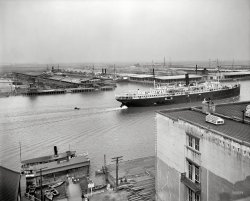
- On the Waterfront: 1905
- ... Presumably they didn't get paid in bananas.
Banana Boat on Bowly's Wharf The steamship Bodø was variously described in ... Posted by Dave - 07/23/2012 - 6:46pm -
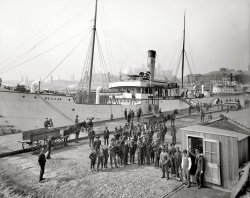
- This Smoky Eden: 1905
- ... Detroit Publishing Company. View full size.
Canal Boat Carl T. Seibel There is a town about 10 miles up canal from this ... ça change Twenty five years ago I brought my folks' boat down through this area of the canal. Then it ran down the Mohawk with the ... Posted by Dave - 01/03/2018 - 10:13pm -
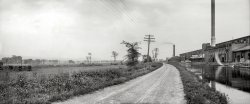
- Budmobile: 1924
- ... manufactured in St. Louis up to about 1924.
Bevo Boat Various internet resources ( 1 , 2 , 3 ) refer to this vehicle as a "Bevo Boat" or "Land Cruiser," used to promote Anheuser's Bevo beverage . The ... Posted by Dave - 07/24/2012 - 9:47pm -
![Budmobile: 1924 Washington, 1924. "Helen G. Sweeney, Adolph Busch, Joseph Gallegher, Henry Glyn." Helen, who as Miss Washington represented the District of Columbia in the 1924 Miss America pageant, was also Miss Treasury Department that year. She's shown here in front of the Treasury building in a nautical-themed car bearing the insignias of Anheuser-Busch and Budweiser, promoting the company's beverages during the Prohibition years. National Photo glass negative. View full size.
Mutiny on the BuschIt appears that the Captain was set adrift without a paddle.
Beep beep!That cannon is one way to deal with slow lane hogs. Even more so if you're all drunked up on the family brew!
Ginger AleI can see that during Prohibition the Bud people were selling soft drinks. From a marketing standpoint, had they continued, they could have been a formidable competitor to the other bottlers. They sure know how to sell beer, but by law, they are limited to who can buy it. If they produced a full line of soft drinks, Anheuser-Busch has the customers (the supermarkets, etc) and it's got to be much easier to produce.
[The company's main product during Prohibition was low-alcohol beer. Below, a Bud ad from 1924. - Dave]
Little AugieAccording to the Budweiser website, 1924 is the year that young Augie Busch, Jr. began working for the family firm. Looks like they gave him all the worst assignments!
Mrs La Follette's carBeneath all the gear from West Marine is the same sort of car used by Mrs Robert M. La Follette when she was stumping for her husband in 1924. So, what make of car is this? Somewhere, a Shorpy fan must know!
https://www.shorpy.com/node/4409#comments
Blub BlubIt makes me laugh to think if this car were around today it would only take a few beers before someone drove it into a lake. The front bumper anchors could prove a fatal flaw in the design though.
Sure seems related to this vehicle…An older brother to these 1930 Cadillacs perhaps?
http://www.car-nection.com/yann/Dbas_txt/DRM30-32.HTM (scroll down)
The only possible response"Get a Clydesdale!"
Maybe a MorrisThe shape reminds me a bit of the emblem that Morris Garage attached to the MG, which was octagonal. So this may be an early Morris.
Vehicle nameI think the hubcap says Dorris, a vehicle manufactured in St. Louis up to about 1924.
Bevo BoatVarious internet resources (1, 2, 3) refer to this vehicle as a "Bevo Boat" or "Land Cruiser," used to promote Anheuser's Bevo beverage. The model shown here, the first in the series, was manufactured during WWI, supposedly on a Pierce Arrow chassis. Originally used as a recruiting tool during the war, it was later repurposed for advertising.
Amazingly, some of the internet references for this vehicle suggest that it was truly amphibious. Seems a stretch to me.
One more image from the internets: photo #106 at Mystery Cars.
The cannons on the rear fenders (there is one on the other side as well) were working models of the Winchester 10 gauge breech loading cannons. Intended to discourage pursuing pirate boat cars?
Olympic Gold MedalFugliest car ever.
Solved?It appears that sharp-eyed Shorpy-ians (Shorpy-ites?) have solved another mystery. I could not discern the "D" on the hubcap, so thanks from me. It may be that Dorris is still in business..
http://www.dorrisco.com/about.htm
DorrisThe hubcaps are certainly Dorris.
http://en.wikipedia.org/wiki/Dorris_Motors_Corporation
Bevo BoatmobileFrom Hemmings, more on the Anheuser Busch Bevo Boatmobile.
Turn SignalLove those cannons. I could sure use one on my car.
(The Gallery, Cars, Trucks, Buses, D.C., Natl Photo)](https://www.shorpy.com/files/images/26184u.thumbnail.jpg)
- Poughkeepsie Panorama: 1908
- ... Company. View full size.
The Boys in the Boat I just finished "The Boys In The Boat" by Daniel James Brown, the story of the 1936 Olympic eight-man rowing ... Posted by Dave - 11/21/2013 - 11:12am -
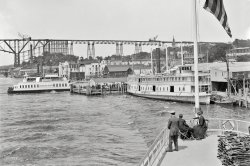
- Landship Recruit: 1917
- ... depicting life around and aboard the landlocked boat. 5x7 glass negative, George Grantham Bain Collection. View full size. ... a 5 or 10 minute walk apart, easy mistake.
Addie
A boat in the park Some comedians joke about how men flock to building sites ... Posted by Dave - 09/11/2011 - 10:55am -
![Landship Recruit: 1917 New York, 1917. "Landship Recruit on Union Square." The U.S.S. Recruit, a wooden battleship erected by the Navy, served as a World War I recruiting station at Union Square from 1917 to 1920, when it "set sail" for Coney Island. This is the first in a series of photographs depicting life around and aboard the landlocked boat. 5x7 glass negative, George Grantham Bain Collection. View full size.
Clever recruitment toolStanding next to a (presumably) life-sized wooden mockup of a battleship probably wowed more than a few citizens into sailorhood. Pretty clever idea for recruitment.
[Plus, as we shall see, there was dancing and free medical checkups. - Dave]
Union SquareThis photo was probably taken from the Flatiron Building. If you were to stand in the same window, the image would be almost perfectly unchanged, with the exception of the Empire State Building poking up in the background.
Water TowerCan anyone decipher what's written on the water tower to the left of the Metropolitan Life Insurance Building?
[Meyer something. Or maybe not. - Dave]
Union SquareThe tall tower in the center background is the Metropolitan Life Tower that we saw a few weeks ago in another early photo. The building directly in front of it closest to the park is 33 East 17th Street, which houses a huge (for Manhattan) Barnes & Noble on its lowest three floors.
That northern end of Union Square hosts a farmer's market, the Greenmarket, that attracts local farmers as vendors. It is quite popular and has great fresh produce, flowers and other products. It is well attended.
However, a local restaurateur is attempting to build a high-end eatery there and has run into massive local resistance, putting the project is on hold.
Union Square is a gathering place for young people, artists, anarchists, political activists, kooks and interested bystanders. It doesn't get as many tourists as it should but it is a tremendous NYC attraction.
Vantage PointThe Flatiron building is at the southwest corner of Madison Square Park at 23rd Street, not Union Square at 14th.
Union SquareYou might be thinking of Madison Park and 23rd st, instead of Union square and Union Square Park at 16th street. They are only a 5 or 10 minute walk apart, easy mistake.
Addie
A boat in the parkSome comedians joke about how men flock to building sites and here we have that cliche demonstrated.
However this time, at least, it makes sense to me, a boat developing right in the middle of Union Square Park?? Wow!
Addie
Landship Recruit in WikipediaI was so fascinated about this photograph that I started researching the Landship Recruit. JSTOR had nothing and Google was pretty sparse, so I cobbled together what I could and made a Wikipedia page. Take a look and add to it if you are so inclined:
http://en.wikipedia.org/wiki/Landship_Recruit
[As you note at the end, there are a number of articles about the Recruit in the NY Times archive from 1917 to 1920. At least six that I can find. - Dave]
Oops, you are correctMy brain was a little fried when I wrote that about the Flatiron. I hold by the rest, though -- all the buildings visible in this photo remain, though the Empire State Building would now be visible in the background.
Missing BuildingThe "House & Garden" Travel building is gone now, a much shorter building is in its place. The photo is facing the northeast, the USS Recruit must have taken up the entire park.
The WW2 version of the USS Recruit was a minesweeper (AM-285). There is also a USS Recruit which was a commissioned US Navy vessel (TDE-1) from 1949 to 1967, despite also being built on land like its namesake. It remains in place in San Diego, next to the Harbor Drive bridge over San Diego Bay.
S. Cottle & Co.: New York, Silversmiths 1877-1920
Just south of Union Square Parkis a modern building housing Whole Foods, Filene's Basement, and DSW. Each store has large picture windows, and having stared out them many times myself, watching activity in the park, I have to guess that where that building stands now was also the vantage point from which this photo of the Recruit was taken.
Which means if any of your NY-based readers are so inclined, they could take a photo of the area from that building to show us how similar the view is today. I'd happily do it myself if I still lived in New York.
I'll bet the Armynever built a replica of WWI trench warfare as a recruiting tool.
USS Recruit San DiegoThere was/is a USS Recruit at the former San Diego training center. She is essentially concrete, on land and I trained on her.
(The Gallery, Boats & Bridges, G.G. Bain, NYC, WWI)](https://www.shorpy.com/files/images/24400u.thumbnail.jpg)
- Four Guys: 1900
- ... glass negative. View full size.
Row, Row, Row Your Boat Or maybe these are dads of four Olympians from "The Boys in the Boat," relying on genetic memory to get that gold in Berlin.
2nd from the ... Posted by Dave - 10/06/2017 - 10:40pm -
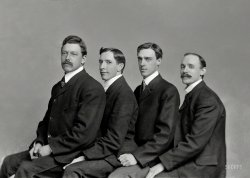
- Unknown Biplane
- ... Thanks for looking. View full size.
Benoist Flying Boat & Tony Jannus Correct, on the right is Antony "Tony" Habersack ... Type XIV This appears to be a Benoist Type XIV flying boat, used in 1914 on one of the first commercial US air services, from Tampa ... Posted by burmashave - 02/08/2010 - 12:22pm -
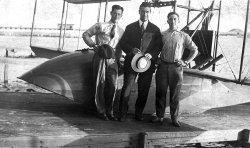
- On the Waterfront: 1941
- ... 4x5 Kodachrome transparency by Jack Delano.
The Boat Looks like they're careening the boat at pierside. That's when they expose the hull by leaning it to one side ... Posted by Dave - 08/30/2012 - 12:03pm -
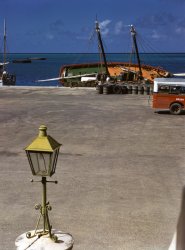
- Starlight Park: 1921
- ...
Performances
Show Boat [Broadway]
Original Broadway Production, 1927
Lady of the Ensemble
... to get to work on one not made out of wool...
Re: Show Boat She's a chorus girl, too? Can she GET any more awesome?
Why this ... Posted by Dave - 07/27/2012 - 12:24pm -
![Starlight Park: 1921 June 1921. Eleanor Tierney at Starlight Park on the Bronx River at 177th Street. Eleanor, a Broadway chorus girl, married a banker and ended up in Larchmont. 5x7 glass negative, George Grantham Bain Collection. View full size.
Hairy gamsShe has more hair on her legs than some of those Confederate soldiers had on their chins. I bet it's a good thing her arms aren't raised.
EleanorYou could almost think this was a recent photo. She has a very modern look.
The suitWas this bathing suit considered risque at the time? I wonder, only because so-called "modesty suits" which are marketed to (mostly extremist) religious women these days (i.e. http://www.swimoutlet.com/product_p/11745.htm ) offer significantly more coverage than this item from nearly 90 years ago.
[It's not unusual for a 1920 bathing suit. - Dave]
Itchy & ScratchyThat suit looks mighty itchy... Is it wool?
A Little ChubbyA lot of those 1920 bathing beauties seem to be slightly pregnant I guess they weren't into washboard abs or heroin chic.
Grooming NotesWow, I guess women of the 20s were not too worried about shaving their legs. Of other interest, it appears that there is more material on the men's bathing suits of the day than on Eleanor's!
A real woman*sigh* every chorus girl's dream: to marry a banker and move to Larchmont....
RE: "Chubby," Seems that some men today are too used to the hyper airbrushed "perfect 10's" they see in the media. As apparent in comments seen here and elsewhere on Shorpy. Someone always seems to pipe up about weight.
Most women share a shape similar to Eleanor's. Not fat, not skinny, not hard-bodied, not total slobs--just real and healthy.
That being said, most of us do shave our legs nowadays.
Comment criteria?I find it interesting that every comment I've submitted to this site -- which have had to do with artistic decisions in photographs or societal conditions at the time the photos were taken -- has not appeared in the threads, and yet comments about the hair on this woman's legs or that say she looks "slightly pregnant" (please, calling her "a little chubby" is absolutely ridiculous) pass muster. This is a private blog, of course, and you may post comments or not as you please, but this thread is a bit annoying.
[Indeed. - Dave]
I like her attitude.I would seriously like to go back in time and hang out with this girl.
Concrete beach?What is she standing on?
[Concrete paving. - Dave]
Starlight ParkFrom what little I can find about Starlight Park, it was at 177th and Devoe and closed around 1940. The site is now occupied by a city bus barn.
From other writings, Eleanor was apparently standing on a "beach" at the edge of a large wave pool on the park grounds.
The chin-up pose is striking. Eleanor had confidence.
She's all that...and she knows it! Here's a woman with a healthy confidence and outlook!
Real women, indeedI agree that normal women are shaped like this young lady, if they're lucky; she was indeed a beautiful girl.
As a guy in his 60s, I would point out that the rage for anorexics is a fairly recent one, and I think that even young men would largely prefer a healthy woman to one who is obsessed with her weight. It seems to me that this is something that women have brought on themselves in the last 25 years or so. Maybe not.
It's also true that men like me knew lots and lots of unshaven European and American girls in the '60s and '70s. Natural and feminine women can be devastatingly attractive.
ShowboatAccording to
http://broadwayworld.com/people/Eleanor_Tierney/
Performances
Show Boat [Broadway]
Original Broadway Production, 1927
Lady of the Ensemble
More New York City photos requested...More photos of people and places in New York City that are no longer "there" would sure be welcomed here, a la' the vast file of DC scenes you've published to date.
[We have more than 400 NYC photos on the site. - Dave]
Where it was...If I'm reading my Yahoo! Map correctly, Starlight Park in the Bronx was just about where the northern terminus of Sheridan Parkway feeds off to East 177th Street, very close to East Tremont Avenue. The Bronx River is basically clean where in runs through the NY Botanical Garden, but I don't think I'd want to take a swim it it today where Starlight Park used to be.
Who wants plastic anorexia?I'm a relatively young man myself (37) and it's all the starved carpenter's dreams walking around these days that makes me really appreciate the beauty of this photo. Nothing fake or plastic here - to paraphrase, "it's all her, baby!" - and that's how I personally prefer women, inside as well as outside.
Since we're on the subject of "modern" women vs. the extremely appealing jazz babies I've seen here thus far, my question is, why on God's green earth have hips and real busts been outlawed the last 3 decades or so?
Dave, I can't tell you what a wonderful job and service you're doing. The streetscapes - as well as the jazz babies, among the many other things here - are exceptional!!!
Twiggy Go HomeTo answer the SwingMan's question: It's that darn Twiggy in the early 1970's. I wish she had quickly crawled back into the golf hole from whence she came.
*sigh*"It's also true that men like me knew lots and lots of unshaven European and American girls in the '60s and '70s. Natural and feminine women can be devastatingly attractive."
Heck, yes. That's a reason I keep coming back to this site.
The Hepburn FactorTwiggy was a latecomer in the thin-is-stylish sweepstakes. It actually dates back to Audrey Hepburn, the quintessential high-fashion template of the 50s. On a related note, let's not forget that of Katharine Hepburn (no relation), Spencer Tracy said, "Not much meat on her, but what there is is cherce." YMMV, of course.
Almost Nekkid!For its moment, ca. 1920, this is a mild news service cheesecake photo produced for one of New York's many illustrated dailies. Eleanor Tierney's two-piece wool jersey bathing suit is acceptable in 1920 but a bit risque in its lack of a skirt. Many women continued to wear corsets under their bathing suits until the mid-teens at least, and one-piece bathing suits for women would remain illegal on many American beaches until the early 1930s. Many viewers at the time would have considered her "almost nekkid." With her casually proud stance and short hair, Eleanor is expressing modernity and liberation from older values, embodying social changes that were exciting, controversial and hotly debated throughout the country.
Real WomenOnce again, Shorpy proves why it is my daily online morning ritual. Cup of coffee in hand, I have to peruse the jewels set up for daily display.
As a woman who would have been described a "sweater girl" back in the good old days, I have always been amazed and a bit irritated how normal, healthy women in pictures such as this are berated in the comments on Shorpy for their weight when they have the curves and lovely meat a woman is supposed to have.
I'm very glad I resemble Mae West rather than Twiggy, and I know not a few men who are as well.
Flat-Chested FlappersOdd that so many readers view thinness as a purely modern fashion phenomenon, although our rail-thin models are a record-setting extreme. By the mid-1920s the ideal beauty was "boyish," with very slim hips, long legs, a flat chest and very short hair. This was the culmination of a revolutionary fashion trend that began during World War I with "mannish" dresses that suppressed the hourglass body shapes of the 1890-1910 period. In the 1920s John Held's covers for Life and Judge magazines featured girls with barely noticeable breasts and no waistline. This is the basis for the joke in "Some Like It Hot," when Marilyn Monroe envies Jack Lemmon's figure (in drag). She says that his beaded necklace hangs straight, and complains that hers just go all over the place.
The Boyish LookSetting aside the fact that had the current fashion for anorexic actresses been in place fifty or sixty years ago we would have been robbed of the pleasure of watching Marilyn Monroe, the boyish look of the '20s was quite common, and would later come to be thoroughly misunderstood. If you've ever seen a not very good movie called "Getting Straight" which starred Elliott Gould and Candice Bergen, you may recall a scene in which Gould's character is defending his thesis on his favourite book "The Great Gatsby." One of the professors insists that Fitzgerald's description of Daisy is distinctly boyish and points to this as proof of Gatsby's (and maybe even Fitzgerald's - it's been a long time since I've seen the film) suppressed homosexuality. I at least see it as being as much a product of the fashions of the times as the descriptions of blacks in other novels of the period.
My Two CentsNot to belabor the point regarding women's curves, I can only think of the classic artists whose magnificent paintings of beautiful, fleshed-out female forms are unintentionally so much more interesting (as in erotic) than would be bone-thin, shapeless females exhibiting a dearth of both feminine hormones and sex appeal. Take for example Venus, September Morn, the entire works of Rubens, Botticelli and hundreds of other artists and paintings that celebrate the true nature of the female form. Of course, then we have Botero, who makes all his figures very short and very stocky, but they are such great fun to look at. I can't imagine the great painters even desiring to paint the anorexic girls on the runways today. Just had to add my humble opinion to the mix. Thank you for not only the fascinating photos but also the stimulating discussions they inspire.
EleanorEleanor, gee I think you're swell, and you really do me well, you're my pride and joy, etcetera... ©the Turtles
...this beauty can model for me any time.
WOW...That is some hairdo! Very pretty woman.
Can this be back in style?I absolutely love her bathing suit. I may need to get to work on one not made out of wool...
Re: Show BoatShe's a chorus girl, too? Can she GET any more awesome?
Why this photo?DO you know why this photo was taken? Was it a private photo? Or was it taken as publicity for the show she is appearing in at the time (being a chorus girl) or for the park itself? It has all the hallmarks of a professional photo due to the angle and her stance.
[The Bain News Service photos were all professional. - Dave]
EleanorSomething about the way she is standing and the look on her faces tells me that Eleanor might have been that girl who knew how to have a good time. Love the photo.
Eleanor TierneyAccording to census records and the NY Times archives, Eleanor married John A. Van Zelm. He died of pneumonia on August 1, 1937. Eleanor died on June 22, 1948.
Chubby? Slightly Pregnant??!!Honestly, get a clue. She just happens to have internal organs. Gee,if only they could come up with plastic surgery to remove them.
Starlight Park in my LifeI admire the candid of Ms. Tierney, but the background is most interesting. I knew Starlight Park more than a quarter century later. By then there were no remnants of roller coasters or the like. The arena had been converted to a bus barn by Third Avenue Transit( taken over and operated now by the government transit op.) Many of the stucco buildings with red tile roofs were either destroyed,falling down or abandoned playgrounds for kids. That pool she is standing beside had a large sandy beach area and was of monumental proportions. It was the length of a football field, oriented east-west. At the west end, beyond the paved promenade, was a retaining wall and the land fell off sharply to the Bronx River. When this photo was taken this was largely an area that was undeveloped.
The 180th Street Crosstown trolley (X route) went by and there was the West Farms junction of several trolley routes (after 1948 all buses) about a quarter mile away. The White Plains Road IRT elevated line with a Bronx Zoo destination had a stop another few blocks further west.
In the 1940s when I frequented the place, it was because I accompanied my father, who was a soccer buff, when he went there on Sundays to doubleheaders of the German-American Soccer league. Not withstanding the leagues moniker; the NY Hungarians, Praha, Savoia, Hakoah, Eintracht, Brooklyn Wanderers, Bronx Scots, my old man's former team the NY Corinthians, and a plethora of teams with non-teutonic associations made up the league. There were professional leagues that had a larger territorial range, but almost all of the players in those days were either immigrants, or their first generation progeny. The GA was the MISL of that time. There was no real money to pay living wages to soccer players so either industrial teams, like the Uhrich Truckers in St. Louis, or semi pros - like those from the G-A league were the source of the best players in the country. Yogi Berra, and Joe Garagiola who grew up on "The Hill" in St. Louis, were part of a similar world and played soccer for local Italo-American sides there as children and teens.
I know this seems strange, when the American goalie Brad Fridl pulls down 5 million bucks from Aston Villa in Birmingham in the UK Premier League, but until the Spaniards and Italians started offering whatever wages they would to get the best players, the British paid washers to professional soccer players. Ten pounds a week was the fixed rate in the forties for UK soccer players. Liverpool offered a NYPD sergeant named Miller, who was the G-A all star teams goalie, a contract. He would have had to have taken a substantial pay cut to have gone there. Foreign wage pressures, and the fixing of games by underpaid players has changed that forever. The Post War would change everything, but meanwhile the German-American League was the best we had.
In the early 1950s, I was at Randall's Island Stadium when the G-A League All Stars beat Kaiserslauten , the German Bundesliga champions, 2-0. So Starlight Park's large playing field, north of the pool site ruins, was, along with Sterling Oval, and a field across the road from Con Edison in the south Bronx, were the places where the best soccer in the US was being played.
As a young kid, I and the sons and daughters of the immigrants tore around the ruins playing games, built fires to roast spuds and marshmallows and the like, while our parents watched the games and relived their own athletic youths. Unfortunately, it wasn't all a halcyon time in the ruins for us. Charley, a 12-year-old acquaintance, was murdered by a sexual pervert there after swimming in the Bronx River.
I never knew the place in its heyday, and I wish I had been there to ride the roller coaster and swim in such an immense pool. Still, it provided a different set of experiences and meaning to another generation.
Good-Luck,
Peter J.
Eleanor in ColorWhen this photo originally appeared on Shorpy last year, I decide it was a good experiment for hand-coloring. I did this in Adobe Illustrator CS2, not a traditional photo-manipulation program. With the recent mania for colorizing, I thought I'd jump on the bandwagon. Fire away, philistines!
[The system deleted your attachment because it was wider than 490 pixels. Please read and follow the posting instructions! - Dave]
More Starlight PixI first became aware of Starlight Park from a photo in Roger Arcara's "Westchester's Forgotten Railway" (1960). Now, the Internet and this web page have opened a whole new box of nostalgic pleasures. I have uploaded more Starlight Park pix here.
Beach hairYes, it appears that Eleanor is both confident and fun-loving! It also appears that (by the look of her carefree 'beached-out' tresses) she has been SWIMMING this lovely day. This makes me very happy! I imagine that not too many women of the day would purposely submerge their HEAD in the salt water, much less consent afterwards to having their portrait made. That said, I have no doubt that for stage and most all other social appearances, Eleanor made diligent use of hair straightening rods, pin curlers, scented hair oils, etc. How do I know this? I (and all the other women in my family) have Eleanor's hair.
Pool I wonder how they took care of keeping a pool of this size clean in 1921. I don't think they had Olin's HTH product at the time.
(The Gallery, G.G. Bain, NYC, Pretty Girls, Swimming)](https://www.shorpy.com/files/images/32491u1.thumbnail.jpg)
- The Vestal: 1908
- ... View full size. George Grantham Bain Collection.
big boat what a fantastic photo, I wonder who the gentleman with his top hat off ... Posted by Dave - 12/10/2007 - 5:03pm -
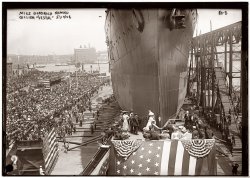
- Sailing on the Sand: 1903
- ... Midwest thet thar is known as a "prairie schooner."
Boat For Hire It appears that one could buy rides on that contraption. ... Posted by Dave - 10/15/2012 - 9:26am -
![Sailing on the Sand: 1903 Circa 1903. "Sailing on the beach at Ormond, Florida." An interesting looking character at the controls. 8x10 glass negative, Detroit Publishing. View full size.
Major Hoople Au Bord de la MerA fez and a wool suit, Florida weather -- and Arrid won't be invented for a few years yet. The pilot looks as if he's calculating whether he can run over the photographer before the latter can gather up his tripod-mounted view camera and skedaddle (they still did that back then).
[Our captain would be bundled up against the chill -- Florida was a winter resort. -Dave]
In the Midwestthet thar is known as a "prairie schooner."
Boat For HireIt appears that one could buy rides on that contraption. Similar to the present day's hang gliders. In the background we see a couple of bicycle people movers.
Appropriate PhotoI just returned from my 50th High School Reunion in Daytona Beach (on the south edge of Ormond Beach for those that don't know). Everything is a lot different now than it was back then although I think it was better 100 years ago than now. We walked on the beach and in the ocean while there. The beach is much narrower now, even at low tide and they now charge a fee to drive on the sand. Great photo and I have enjoyed this one and the other photos of Daytona Beach shown on this site. They bring back memories of a time that will never come again. Thanks a lot.
(The Gallery, Boats & Bridges, DPC, Florida)](https://www.shorpy.com/files/images/SHORPY_4a10867a.thumbnail.jpg)
- Second Varsity: 1914
- ... the money to redo the pitiful Varsity Crew quarters and boat- houses the famous race just moved out to a place that treated them as ... give anything to go back there for a day.
Boys in the Boat I recently read The Boys in the Boat, about the 9-member University of ... Posted by Dave - 06/26/2014 - 3:56pm -
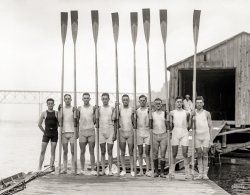
- S.S. Cabrillo: 1910
- ... lost coins offshore, too.
Glass Bottom Boat
Change Is Good The fellows standing in the rowboats gathered ... Posted by Dave - 07/26/2019 - 4:18pm -
